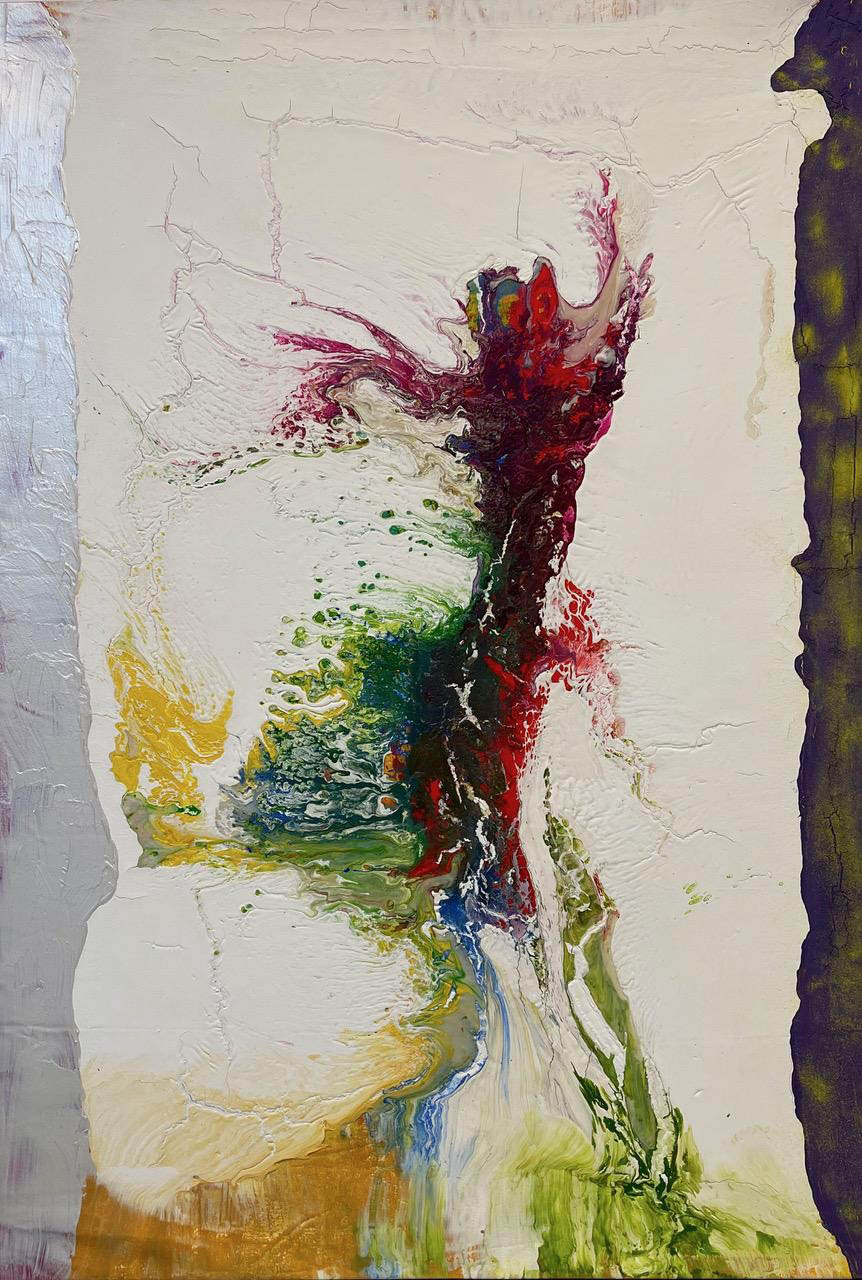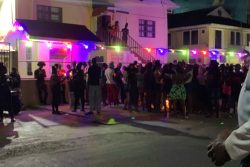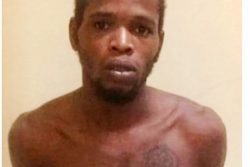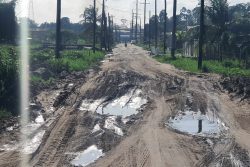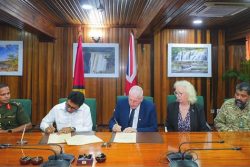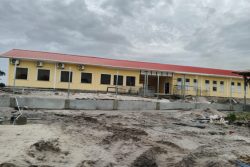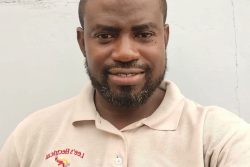 Considering Guyana’s small population and its cultural and linguistic isolation on the South American coast, curiosity is always the order of the day for me when I learn of Guyanese in strange and far-flung places. Mazunte, Oaxaca Mexico seemed to be the oddest place to find an Agricola-raised Guyanese painter. But considering the painter in question, I suppose it was not altogether surprising. Arlington Weithers’s journey in art has cruised along a highway not frequented by Guyanese, and the pivotal turns seem to have come by way of errands and favours. An errand as a boy led to him meeting Vivian Antrobus (ca 1907 – ?) who ultimately suggested that he further his studies at the Arts Student League of New York. That he did. That story was documented in last week’s article. Decades later (and certainly not the second or last) a favour for his friend, Panama-born Victor N Smythe, former archivist and curator at the New York Public Library’s Schomburg Center, led to a road trip from New York City to Mazunte, Mexico which he likened to “a kind of spiritual journey.”
Considering Guyana’s small population and its cultural and linguistic isolation on the South American coast, curiosity is always the order of the day for me when I learn of Guyanese in strange and far-flung places. Mazunte, Oaxaca Mexico seemed to be the oddest place to find an Agricola-raised Guyanese painter. But considering the painter in question, I suppose it was not altogether surprising. Arlington Weithers’s journey in art has cruised along a highway not frequented by Guyanese, and the pivotal turns seem to have come by way of errands and favours. An errand as a boy led to him meeting Vivian Antrobus (ca 1907 – ?) who ultimately suggested that he further his studies at the Arts Student League of New York. That he did. That story was documented in last week’s article. Decades later (and certainly not the second or last) a favour for his friend, Panama-born Victor N Smythe, former archivist and curator at the New York Public Library’s Schomburg Center, led to a road trip from New York City to Mazunte, Mexico which he likened to “a kind of spiritual journey.”
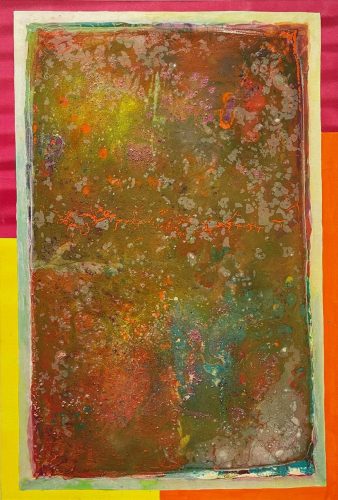
96” x 64” (2003)
Departing New York City in October 2003, Weithers and Smythe drove away from the engineering masterpieces of glass-clad high-rises to the beauty of the tree-covered undulating mountain range of the Sierra Madre, from the Atlantic to the Pacific, and from subterranean locomotion to a snippet of a vast subterranean nesting ground for Olive Ridley sea turtles. Along the way to the southern state once in Mexico, Weithers was able to visit six of the Olmec colossal heads (giant sculptural stone heads of pre-Columbian origin) and work by the famed Mexican muralist and pioneer of mural art Diego Rivera. Weithers spent nearly a year in Mazunte. Happily, his time there was not that of a beach-bumming idyll. Although I suspect there was some of that, it was a time for further gestation and birthing of ideas, a rhythm mirroring the importance of the place.
The Mazunte series of paintings number four. They range in size from 30” x 24” to 92” x 73” The work has an environmentalist ethos but does not speak to desecration and degradation of land. Instead, the paintings focus on celebrating the idiosyncrasies of nature. Weithers describes his work as leaning on “ecological symbolism” and a continuation of the thinking informing his series of paintings based on the Book of Revelation in which he tried to reflect God’s concern for the earth. No doubt, as part of his Mazunte gestation, Weithers meditated deeply on the workings of the universe and the workings of the higher power in his life, whom he is happy to name God. The stories he shares about his time there are deeply personal and evidence an individual who is and has been for a substantial period anchored in a belief in One far superior to himself.
The paintings in Weithers’s exhibition Organic: Imagery and Processes Inspired by the Natural World relate to Guyana; Mazunte, Oaxaca Mexico; laboratories in Upstate New York; and so much more. However, foregrounded in the exhibition and positioned as the ideological and aesthetic nucleus of the show are the Mazunte paintings.
“Nostalgic memory in situ.” This is how Weithers describes the influence of the place of his birth on his painting process. He explains: “My memory of Guyana is idyllic. Remember, I arrived in New York City before age 21 so the original purity of Guyana is what remains in my mind. […] People don’t talk about it much but the light and colour in Guyana is different. I like to call it an equatorial light. As artists, we deal with light and colour and [Guyana’s light is] amazing because we are in this intense light. […] As a boy, I was fascinated for instance when I would go out to the seawall, I would look out longingly because at that time most of the travelling was literally by ship and at midday when you look out at the Atlantic Ocean, to the horizon, you got this amazing shimmering effect – the shimmering effect of the light kissing the water and those are the things that inform my painting. […] The deep colour of the hibiscus, the colour on the breast of the kiskadee, all of those things are what inform the work.”
We speak about turtles and coconuts and the debris of the Pacific tides delivered and taken away. I tell him I like the Hancock Street Series: Snow Event and how it is displayed within the space and that there are others that I really like. He is delighted that I am able to read certain textural effects in this work despite not seeing the work in person. The Hancock Street series was done before he went to Mexico. He explains: “In my paintings, you do have a thorough investigation of the painting process and I am deconstructing how one paints and I am rebelling against what constitutes paints. The process [of making paints is you use] polymer emulsion as the clear base, you add the pigments, the pigments are dissolved within this base and you put in emulsifiers to thicken it. And this is where you get the thick paint that artists use brushes and palette knives to apply to canvas.” Weithers continues to explain other paint-making processes and his research with chemists and others at the Golden Paint Company. I get lost in polymers. It is like technology and my head is not malleable to it.
I share with Weithers the following text from the press release: “The large fissures and cracking result from the multiple and thick layers of medium and pigment poured on the surfaces of the canvases and the long drying process. This is a process that further adds to the organic nature of the resulting artworks as the drying and location of the fissures cannot be controlled [or] predicted. Thus, a bit of Zen and ‘happy accidents’ create aesthetic opportunities regarding what the fissures unmask and [how they] inspire the artist’s and viewer’s responses.”
Weithers explains: “The cracking and splitting you see in my work, even though there are references to the land in Guyana, [they are] for me an essence of something else. […] It becomes a metaphor for the human mind and the fragmentation within our lives – relationships for example.”
I say I thought he would tell me something about God. He knows why I say this. He laughs: “Ahhhh. But it also relates to [Guyana’s] independence and the splitting and breaking away.” He relates the fissures to a current war. I interject to avoid a refocus. He says, “I was torn away from Mother Guyana. So, I am fascinated in my paintings with fracture and fracture-cleavage.” I have heard him speak of ‘fracture and fracture-cleavage’ in many other conversations. He continues: “In essence now, coming here and understanding culture and [studying] philosophy, [he references Franz Fanon and Chinua Achebe], I am painting my life. Our lives involve all the layers. To be honest with you now, painting does involve life. Postmodernism does involve fragmentation.”
Weithers’ exhibition Organic: Imagery and Processes Inspired by the Natural World at the David Richard Gallery NY has been extended and now runs until June 9. The works in the exhibition can be seen on the gallery’s website
Akima McPherson is a multimedia artist, art historian, and educator.
